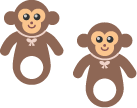Method

YBCR products can be purchased online. However, you can still give your baby a multisensory program of learning without them - and what's more, you can personalize the lessons. For example, you can homemake books using photographs of family members and familiar objects. The YBCR books use a pull-out flap, which encourages the child to read the word before pulling out the associated picture. You can create a similar effect yourself by making flip-open flash cards.
To make a flip-open card, fold a piece of A4 paper in half, write the word on the outside, and stick a photo on the inside, like so:
Mouse over the image to open the card.
If you don't want to make the cards yourself, you can download premade flash cards from a host of pages online, including our own Flash Card Printouts page.
Alternatively, you might want to use the computer to give your baby multisensory reading lessons. You can download PowerPoint slideshows from a number of sources, including our Flash Card Slideshows page. Or you might consider our very own Little Reader Learning System, which is designed to come with a curriculum of preinstalled lessons lasting for one year. Little Reader makes it a breeze to customize your child's lessons, as well as switch between modes of display (choosing word flash, picture flash, or multisensory). For more on the program's functionality, go to The Advantages of Using Little Reader.
Little Reader and the YBCR DVDs also come with an arrow running under words to indicate the direction of reading. This enables children to more easily progress from whole word reading to phonetic reading (sounding out new words). Babies have even been known to figure out the rules of phonics by themselves, as Titzer notes: "Around 18 months I actually thought I would teach [Aleka] phonics, because she knew hundreds and hundreds of words. So I wrote down a 'b' - and I had not taught her the alphabet yet - so when she saw the 'b' she said 'buh.' Then I put down a 't' and she said 't,' and then when I put down 'tion' and she said 'shun,' then I knew that she'd actually figured out phonics."
The more senses you get involved in lessons, the more interesting and fun it will be for you and your child. If you have objects to hand that involve smelling and/or tasting, use them! For example, you can encourage your child to sniff a flower when you teach her the word "flower," or bring out an orange for her to smell and taste when you teach her the word "orange" (please note that citrus fruits are not recommended for babies under a year old).
Don't forget that you can incorporate multisensory learning into your everyday reading of books too. Whenever possible while reading, point out real objects and body parts, make animal noises, and act out words (or help your child to). You should also run your finger under the words as you read, as this will help your child learn to associate individual letters of the alphabet with the sounds they make.
Back
